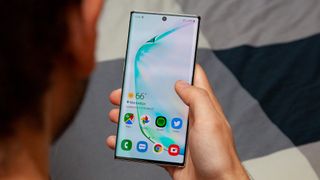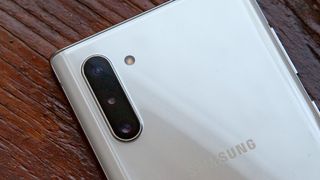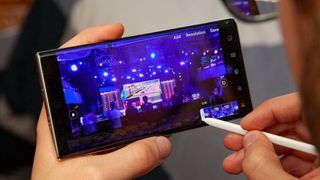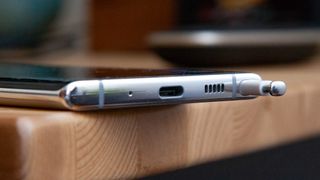The iPhone 11 Pro is here, with Apple touting the device for people who rely on their smartphone to get things done. Which also happens to be Samsung’s pitch in favor of the Galaxy Note 10.
The $999, 5.8-inch iPhone boasts an all-new triple-lens camera system, a refined design and Apple’s new A13 Bionic chipset — the most powerful the company has ever embedded into a phone. Meanwhile, the $949, 6.3-inch Note 10 has its signature S Pen stylus, the narrowest bezels we’ve seen on a flagship handset this year (partially thanks to an Infinity-O front-facing camera cutout) and comes standard with four times the storage of the iPhone 11 Pro.
Which new phone is the best for pro users (or anyone who’s looking for a lot of features packed into their handset, for that matter)? While we’re still testing Apple’s latest phone, here’s how the iPhone 11 Pro and Galaxy Note 10 compare.
iPhone 11 Pro vs. Galaxy Note 10: Specs
| Apple iPhone 11 Pro | Samsung Galaxy Note 10 Plus | |
| Starting Price | $999 | $949 |
| Display (Resolution) | 5.8-inch Super Retina XDR OLED (2436x1125) | 6.3-inch Dynamic AMOLED (2280x1080) |
| CPU | A13 Bionic | Snapdragon 855 (US); Exynos 9825 (WW) |
| RAM | 4GB (rumored) | 8GB |
| Storage | 64GB, 256GB, 512GB | 256GB |
| microSD? | No | No |
| Rear Cameras | Triple: 12-MP wide (ƒ/1.8), 12-MP ultra wide (ƒ/2.4), 12-MP telephoto (ƒ/2.0) | Triple: 12-MP wide (ƒ/1.5-f/2.4); 16-MP ultra wide (ƒ/2.2); 12-MP telephoto (ƒ/2.1) |
| Front Camera | 12-MP (ƒ/2.2) | 10-MP (ƒ/2.2) |
| Battery | 3,190 mAh (rumored); estimated 4 hours longer than iPhone XS | 3,500 mAh |
| Charging | 18W | 25W |
| Water Resistance | IP68; 4 meters up to 30 min. | IP68; 1.5 meters up to 30 min. |
| Size | 5.7 x 2.8 x 0.32 inches | 5.9 x 2.8 x 0.31 inches |
| Weight | 6.6 ounces | 5.9 ounces |
| Colors | Gold, Space Gray, Silver, Midnight Green | Aura Glow, Aura White, Aura Black, Aura Blue |
iPhone 11 Pro vs. Galaxy Note 10: Design
The iPhone 11 Pro is shorter than the Galaxy Note 10, but both devices are just about equally wide and thick. Still, Apple’s handset figures to be noticeably heavier — 6.63 ounces to the Note’s 5.93 — and that’s despite the fact the Note 10 is carrying an entire stylus.
It must be said that the Note 10 offers a fresher design, too, with slimmer bezels, a larger screen-to-body ratio and no notch; instead, Samsung has opted for a very small hole punch-style camera within the display.

iPhone 11 Pro
(Image credit: Tom's Guide)
The iPhone 11 series essentially recycles the design language of the iPhone XS and iPhone X before them, aside from some refreshed materials, like Apple’s new matte-effect glass treatment on the back of the Pro model. Still, the iPhone’s design certainly has a lot of fans, and we like the new Midnight Green color Apple added to the roster (even if it is barely distinguishable from Space Gray underneath most light).
Of course, the biggest difference with the iPhone 11 Pro’s design comes courtesy of its triple-lens cameras — each of which protrudes out of a larger, sculpted square base. It doesn’t look quite as awful as we feared it might from leaked renders, though the camera bump stick out like a sore thumb compared to the Note 10’s more streamlined approach.
iPhone 11 Pro vs. Galaxy Note 10: Display
No matter which phone you choose, you’re getting an HDR-certified, OLED display that can get extremely bright. In fact, Apple says the iPhone 11 Pro’s Super Retina XDR panel can achieve 800 nits under outdoor use, and 1,200 nits in extreme sunlight, when showing HDR content.
Right now, our leader for brightness among OLED displays happens to be the 6.8-inch Galaxy Note 10 Plus, which achieved 686 nits under our light meter. 800 nits would be quite a breakthrough, and you can be sure we’ll put Apple’s claim to the test as soon as we’re able.

Samsung Galaxy Note 10
(Image credit: Future)
In terms of resolution, the iPhone narrowly has the Note beat, with 2436 x 1125 pixels to Samsung’s 2280 x 1080. Couple that with the iPhone’s smaller display size, and Apple’s flagship boasts 458 pixels per inch — 57 more than the Galaxy phablet.
What we won’t be able to evaluate until we’ve spent more time with the iPhone 11 is how accurate and colorful that Super Retina XDR panel is. It will have a difficult time topping the Note 10’s Dynamic AMOLED screen, though, which churned out 125% coverage of the sRGB color space, as well as a Delta-E accuracy score of 0.26. (The closer to zero, the better in that latter test.)
iPhone 11 Pro vs. Galaxy Note 10: Camera and video
Here’s one area that will make or break the iPhone 11 Pro in any comparison. Apple has packed a trio of 12-megapixel cameras into its 2019 flagship — one of which is a telephoto capable of 2x optical zoom, and another that is tied to a 120-degree ultra-wide lens that can pull out to 0.5x zoom. The front-facing camera has also seen an upgrade as well, up from an 7-MP sensor in the iPhone XS to a new 12-MP one capable of slow motion video.
The Galaxy Note 10 also has three lenses of its own on the rear, and on paper, the scheme is similar to Apple’s. The primary 12-MP lens is flanked by 12-MP telephoto and 16-MP ultra-wide shooters, the last of which pulls out to a 123-degree field of view. Samsung has an aperture advantage as well; while the iPhone’s main lens is fixed at ƒ/1.8, the Note’s can switch from ƒ/1.5 to ƒ/2.4, depending on the lighting of the scene.

iPhone 11 Pro
(Image credit: Tom's Guide)
Speaking of light, Apple’s latest flagship is its first with a dedicated Night Mode, that intends to do for ultra low-light photography what the Pixel 3’s innovative Night Sight mode achieved last year. The Note 10 has a similar feature of its own, also called Night Mode, though it didn’t yield the best results in our camera shootout against Google’s handset.
In fact, while the Note 10’s optics compare favorably with the iPhone 11 Pro’s on paper, we’re not so sure Samsung’s computational photography capabilities are strong enough to earn the Korean company a leg up on their rivals from Cupertino. The Note 10 and Galaxy S10 use similar camera systems, and both have a tendency to produce images that are a bit too washed out and lacking in contrast. Shallow depth-of-field portraits in particular have been a major weakness for Samsung, whereas Apple practically invented the feature with the iPhone 7 Plus back in 2016.

Samsung Galaxy Note 10
(Image credit: Future)
The iPhone 11 Pro’s cameras will only continue to get stronger after release as well. A software update will introduce a new feature called Deep Fusion that blends together nine different exposures and then uses artificial to intelligence to deliver one optimized result, pulling the best-exposed pixels from each attempt.
Apple has also renewed its focus on video with the iPhone 11 Pro, as all three of the phone’s rear cameras can capture 4K footage at 60 frames per second, complete with cinematic stabilization. Changing from one lens to another while shooting is seamless because the A13 Bionic chip is always optimizing the tone of the cameras you’re not using to match the active one.
iPhone 11 Pro vs. Galaxy Note 10: Performance
Apple’s new A13 Bionic chipset is backed by 4GB of RAM (according to reports and leaked benchmarks) in the iPhone 11 Pro, and the company claims that combination makes its latest flagships the fastest smartphone money can buy. Again, we’ll be the judge of that once we can share benchmarking results, though those A-series chipset certainly have a reputation for blistering performance — even despite that potentially paltry amount of RAM.

Samsung Galaxy Note 10
(Image credit: Future)
The A12 and A11 generations of Apple’s processor were also the fastest of their time, and compared to last year’s CPU, Apple has boosted each of the silicon’s four efficiency cores and two high-speed cores by up to 20%. Meanwhile, those power cores can be up to 30% more efficient than those inside the A12, which could mean wonderful things for the iPhone 11 Pro’s battery life.
While the A13 is likely to extend its lead over the Snapdragon 855 inside the Galaxy Note 10,, Samsung’s phone benefits from 8GB of RAM. That said, iOS tends to be a bit better about managing background processes and putting a stop to battery-draining software than Android, so we don’t expect Samsung’s memory advantage to make a huge difference in testing.
iPhone 11 Pro vs. Galaxy Note 10: Battery and charging
Apple may not be advertising it, but reports suggest the iPhone 11 Pro has a significantly larger battery than its predecessor, rated at 3,190 mAh. We’ll have to wait until a teardown can confirm it, but if that’s true, the new iPhone’s battery is more than 500 mAh bigger than the one in the iPhone XS, and only 310 mAh smaller than the one inside the Galaxy Note 10.

(Image credit: Future)
Apple says the iPhone 11 Pro should last four hours more longevity on a charge compared to last year’s 5.8-inch model. And for the first time, Cupertino is shipping these premium models with 18-watt USB Type-C chargers in the box. (Previously, iPhone owners had to buy their own fast charger, and the 6.1-inch iPhone 11 still doesn’t come with one.) This faster charger will reportedly get the device to 50% capacity in a half hour. The Galaxy Note 10’s 25W brick got the phone to 47% in the same amount of time in our testing.
The Note 10 averaged 9 hours and 25 minutes in our custom battery test, where we have phones endlessly cycle through a series of webpages at 150 nits of screen brightness, over LTE. That’s still less than the iPhone XS’ 9:41 result, so we’ll be eager to see how much of a difference the iPhone 11 Pro’s new battery makes.
Both devices support wireless charging, but only the Note 10 can wirelessly charge other devices. The iPhone 11 Pro had been tipped to include such a feature leading up to release, though it unfortunately didn’t make it to the final product.
iPhone 11 Pro vs. Galaxy Note 10: Software and special features
The iPhone 11 Pro ships with iOS 13 onboard, which offers new features like Dark Mode, Look Around in Maps, Voice Control for hands-free system navigation and swipe typing. iOS 13 comes out Sept. 19 for current iPhones, one day before the new models arrive in stores.
The Galaxy Note 10 sports Samsung’s One UI interface atop Android 9 Pie, with Android 10 presumably to come next year. However, it’s the device’s S Pen features that really differentiate it from other phones on the market, like the ability to transcribe notes and navigate some apps using the stylus’ Air Gestures. There’s also Samsung’s Dex Mode, which allows you to access a desktop interface for your Note when plugged into a monitor or PC.
iPhone 11 Pro vs. Galaxy Note 10: Price and availability
The iPhone 11 Pro hits stores Sept. 20 for $999, though you can preorder the phone now. For that amount, you’ll get just 64GB of storage. If you want 256GB, It’ll set you back $1,149, while the 512GB model is $1,349.
Meanwhile, there is only one configuration of the Galaxy Note 10, which grants you 256GB of storage for $949. Unlike most Samsung handsets, there is no microSD slot for expandable memory on this phone — so 256GB is all you’ll get. You’ll have to upgrade to the $1,099 Galaxy Note 10 Plus if you want expandable storage.
Outlook
If your phone’s camera is especially important to you, or if you’re an iPhone user who could really use some extra battery life, the iPhone 11 Pro looks like a worthwhile upgrade. (We’ll know for certain after we review the phone.) However, the Galaxy Note 10’s more futuristic design, the added functionality of the S Pen and all the extra storage you get for $200 less than you’d have to pay for a similar iPhone make Samsung’s phablet a better choice for those especially concerned with price.
You can look forward to our full verdict on how the iPhone 11 Pro fares against the Note 10 once we’ve been able to conduct additional testing.
https://www.tomsguide.com/face-off/iphone-11-pro-vs-galaxy-note-10
2019-09-15 10:00:00Z
52780381572103
Tidak ada komentar:
Posting Komentar